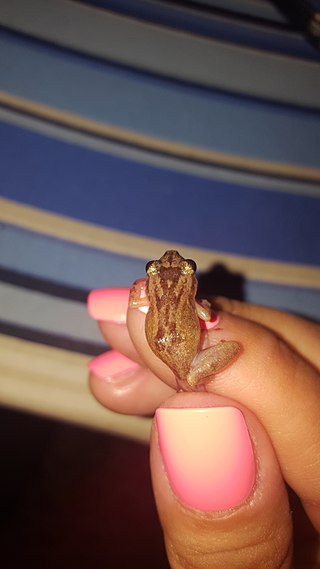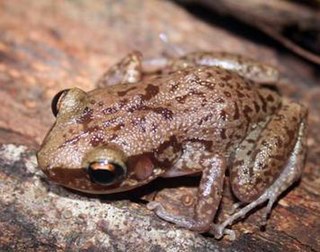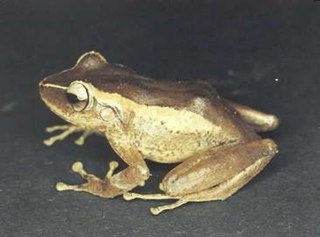
The common coquí or coquí is a species of frog native to Puerto Rico belonging to the family Eleutherodactylidae. The species is named for the loud call the males make at night. This sound serves two purposes. "CO" serves to repel other males and establish territory while the "KEE" serves to attract females. Since the auditory systems of males and females respond preferentially to different notes of the male call, this is an example of a sex difference in a sensory system. The common coquí is a very important aspect of Puerto Rican culture, and it has become an unofficial territorial symbol of Puerto Rico. The frog is also found elsewhere, and is usually considered an invasive species outside Puerto Rico.

The golden coquí is a rare, possibly extinct species of frog endemic to Puerto Rico.

The web-footed coqui, stream coqui, Puerto Rican stream frog or Karl's robber frog, is a possibly extinct Puerto Rican frog species in the family Eleutherodactylidae. It was first described by Chapman Grant in 1931, and was named after herpetologist Karl Patterson Schmidt. It is the largest Eleutherodactylus species of Puerto Rico.

The whistling coquí, Cochran's treefrog, or Cochran's robber frog is a species of frog native to Puerto Rico, the US Virgin Islands, and the British Virgin Islands. This nocturnal insectivore is also referred to as the coquí pitito in Puerto Rico. Their distinctive song is a single, rising whistle, which is repeated and followed by three clicking sounds.
Coquí is a common name for several species of small frogs in the genus Eleutherodactylus native to Puerto Rico. They are onomatopoeically named for the very loud mating call which the males of two species, the common coqui and the upland coqui, make at night. The coquí is one of the most common frogs in Puerto Rico, with more than 16 different species found within its territory, including 13 in El Yunque National Forest. Other species of this genus can be found in the rest of the Caribbean and elsewhere in the Neotropics, in Central and South America. The coquí is an unofficial national symbol of Puerto Rico; there is a Puerto Rican expression that goes, "Soy de aquí, como el coquí", which translates to "I'm from here, like the coquí."

Eneida's coquí is a species of coquí, a small variety of frog endemic to the main island of Puerto Rico and its archipelago. Known as coquí de Eneida in Puerto Rico, this amphibian is mainly terrestrial. Its average adult size is from 1.0 to 1.2 inches. It has a number of small warts located across its back and eyelids. Its main color is a light tone of greenish or grayish brown with a yellow tint on its underbelly. They often have a pair of light colored concave lines located on their backs. Their eyes are golden or green colored, generally dark colored with black venal reticulation. Its habitat is located in mountains that are 1,000 to 3,000 feet above sea level. This species seems to have suffered a population reduction, in the process disappearing from areas formerly considered its natural habitat. The reason behind this reduction is under study, and Eneida's coquí has been designated an endangered species until the cause is discovered. This population decrease is not considered to be linked with the loss of its habitat, which has prevented the protection of its habitat.

The red-eyed coqui, churi, coqui churi, or coqui de las Antillas is a species of frog in the family Eleutherodactylidae that is found in Puerto Rico, the British and U.S. Virgin Islands, and introduced to Panama. Although there are many similar species that are endemic to these tropical locations, its unique physical, habitual, and behavioral characteristics distinguish it from other members of the genus Eleutherodactylus. This genus contains around 185 species that are located in the southern United States, Central America, South America, and the Caribbean, with 16 different species endemic to Puerto Rico. The red-eyed coqui was not brought into Panama City from its native habitats until the late 1960s. There it became established in urban parks before it began to colonize outside the city in the 1980s. In Puerto Rico, the largest island inhabited by the red-eyed coqui, it is found up to 1,200 meters above sea level. It is often compared to the common coqui, Puerto Rico's unofficial territorial symbol, but upon a closer ecological look, the red-eyed coqui has many differences.
The Baoruco hammer frog is a species of frog in the family Eleutherodactylidae found in the Dominican Republic and Haiti. Its natural habitats are subtropical or tropical moist lowland forest and subtropical or tropical moist montane forest. It is threatened by habitat loss.

The grass coqui or coqui de las hierbas is a species of frog in the family Eleutherodactylidae, endemic to Puerto Rico. Its natural habitats are subtropical or tropical moist lowland forest, subtropical or tropical moist montane forest, subtropical or tropical seasonally wet or flooded lowland grassland, plantations, rural gardens, and heavily degraded former forest. It is threatened by habitat loss.

The cricket coqui, green coqui, or coqui grillo is a species of frog in the family Eleutherodactylidae endemic to Puerto Rico. Its natural habitats are subtropical or tropical moist lowland forest and subtropical or tropical moist montane forest.

Hedrick's coqui, the treehole coqui, or coqui de Hedrick is a species of frog in the family Eleutherodactylidae endemic to Puerto Rico. Its natural habitats are subtropical or tropical moist lowland forest and subtropical or tropical moist montane forest.
The half-stripe bromeliad frog or Shreve's robber frog is a species of frog in the family Eleutherodactylidae endemic to Hispaniola and found in both the Dominican Republic and Haiti. Its natural habitats are subtropical or tropical moist lowland forest and subtropical or tropical moist montane forest. It is threatened by habitat loss.
Eleutherodactylus jamaicensis is a species of frog in the family Eleutherodactylidae endemic to Jamaica. Its natural habitats are subtropical or tropical moist lowland forest and subtropical or tropical moist montane forest. It is threatened by habitat loss.

The Antilles coqui, commonly known as the Montserrat whistling frog, Barbados whistling frog, or the Lesser Antillean whistling frog, is a species of frog in the family Eleutherodactylidae found in Bermuda, the Caribbean and northern South America. Its natural habitats are subtropical or tropical moist lowland forest, subtropical or tropical moist montane forest, subtropical or tropical moist shrubland, subtropical or tropical dry lowland grassland, arable land, pastureland, plantations, rural gardens, urban areas, and heavily degraded former forests.

Eleutherodactylus martinicensis is a species of frog in the family Eleutherodactylidae found in Antigua and Barbuda, Dominica, Guadeloupe, Martinique, and Saint Lucia. Its natural habitats are subtropical or tropical dry forests, subtropical or tropical moist lowland forests, subtropical or tropical moist montane forests, subtropical or tropical moist shrubland, subtropical or tropical seasonally wet or flooded lowland grassland, arable land, pastureland, plantations, rural gardens, urban areas, and heavily degraded former forests. It is threatened by habitat loss.

The Mona coqui, coqui de la Mona or coqui de Mona, is a species of frog in the family Eleutherodactylidae endemic to Mona, Puerto Rico. Its natural habitats are subtropical or tropical dry forest and subtropical or tropical dry shrubland.
Eleutherodactylus pantoni is a species of frog in the family Eleutherodactylidae endemic to Jamaica. Its natural habitats are subtropical or tropical moist lowland forest, subtropical or tropical moist montane forest, plantations, rural gardens, and heavily degraded former forest. It is threatened by habitat loss.

Eleutherodactylus portoricensis is a frog native to Puerto Rico that belongs to the family Eleutherodactylidae. Its vernacular English names are upland coqui, mountain coqui, and Puerto Rican robber frog. The species’ range spans the Luquillo Mountains of northeastern Puerto Rico and the Cordillera Central, which forms the highland “backbone” of Puerto Rico and includes an eastern extension beginning at the city of Cayey. However, the species is likely extirpated from the western Cordillera Central.

The bronze coqui, Richmond's coqui, coquí caoba or coquí de Richmond, is a species of frog in the family Eleutherodactylidae. The specific epithet, richmondi, is dedicated to Dr. Charles W. Richmond.

The melodius coqui or coquí melodioso is a frog species in the family Eleutherodactylidae endemic to Puerto Rico. Its natural habitats are subtropical or tropical moist lowland forest and subtropical or tropical moist montane forest. It is threatened by habitat loss.















